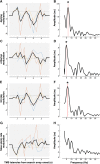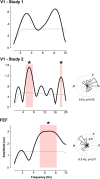Contribution of FEF to Attentional Periodicity during Visual Search: A TMS Study
- PMID: 31175148
- PMCID: PMC6591533
- DOI: 10.1523/ENEURO.0357-18.2019
Contribution of FEF to Attentional Periodicity during Visual Search: A TMS Study
Abstract
Visual search, looking for a target embedded among distractors, has long been used to study attention. Current theories postulate a two-stage process in which early visual areas perform feature extraction, whereas higher-order regions perform attentional selection. Such a model implies iterative communication between low- and high-level regions to sequentially select candidate targets in the array, focus attention on these elements, and eventually permit target recognition. This leads to two independent predictions: (1) high-level, attentional regions and (2) early visual regions should both be involved periodically during the search. Here, we used transcranial magnetic stimulation (TMS) applied over the frontal eye field (FEF) in humans, known to be involved in attentional selection, at various delays while observers performed a difficult, attentional search task. We observed a periodic pattern of interference at ∼6 Hz (theta) suggesting that the FEF is periodically involved during this difficult search task. We further compared this result with two previous studies (Dugué et al., 2011, 2015a) in which a similar TMS procedure was applied over the early visual cortex (V1) while observers performed the same task. This analysis revealed the same pattern of interference, i.e., V1 is periodically involved during this difficult search task, at the theta frequency. Past V1 evidence reappraised for this paper, together with our current FEF results, confirm both of our independent predictions, and suggest that difficult search is supported by low- and high-level regions, each involved periodically at the theta frequency.
Keywords: FEF; TMS; V1; periodicity; theta; visual search.
Copyright © 2019 Dugué et al.
Figures



References
-
- Ashbridge E (1997) Temporal aspects of visual search studied by transcranial magnetic stimulation. Neuropsychologia 35:1121–1131. - PubMed
Publication types
MeSH terms
LinkOut - more resources
Full Text Sources
Miscellaneous
